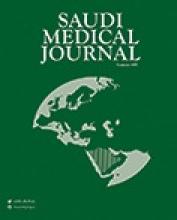SYSTEMATIC REVIEW
Level of evidence of abdominal surgery clinical research in Saudi Arabia
Maghrabi et al quantify and evaluate the level of evidence (LOE) of Saudi publications in abdominal surgery and correlate the obtained results with that of other similar national and international studies. They observed that LOE of Saudi publications in abdominal surgery has not changed greatly over the period of 16 years. There is a strong need to produce high-level LOE studies, since the characteristics of the Saudi population is different from other populations, and such studies would result in better patient care. This might not be feasible without the national collaboration of various institutions; which can probably be best achieved under the umbrella of a scientific society.
Schematic representation of the review process.
see page 788
ORIGINAL ARTICLES
Determination of lumbosacral transitional vertebrae in kidney urinary bladder x-ray films in the Saudi population
Khashoggi et al investigated the rate of occurrence of lumbosacral transitional vertebrae (LSTV), spinal variant, in kidney urinary bladder (KUB) plain radiographs in a Saudi population. A total of 2078 patients underwent KUB examinations during the study period; LSTV anomalies were detected in 158 of these. Sacralization was present in 153 (96.8%) of this cohort, while lumbarization was present in 5 (3.2%). They conclude that the prevalence of LSTV in Saudi patients is 7.6%, with a higher incidence of sacralization than lumbarization.
Frequency of various type of sacralization and lumbarization
see page 794
Incidence and molecular characterization of the extended spectrum beta lactamase-producing Escherichia coli isolated from urinary tract infections in Eastern Saudi Arabia
Mashwal et al find the prevalence of uropathogenic Escherichia coli (E. coli)-producing extended spectrum beta lactamase (ESBL) at King Fahd Military Medical Complex in Dhahran (KFMMC) and to detect the genes responsible for its production. In addition, we determined the pattern of multi-drug resistance among isolates. A total of 117 uropathogenic E. coli isolates were collected. Their findings indicated that there is a high incidence of ESBLs among the E. coli isolated from UTI (23.1%).
Comparison between Quinolone and extended spectrum beta lactamase (ESBL)
see page 811
CASE REPORT
Severe aortic regurgitation complicating Takayasu’s arteritis
Alali et al present a 48-year-old female patient from the southern part of Saudi Arabia, diagnosed 2 years earlier with dilated cardiomyopathy (DCM) and severe aortic regurgitation (AR). She presented acutely with intractable cough, worsening of breathlessness on exertion along with orthopnea and occasional paroxysmal nocturnal dyspnea. Her New York Heart Association (NYHA) HF classification progressed from class II at the time of the diagnosis 2 years ago to class IV on her latest presentation.
Complete occlusion of the right internal carotid artery and irregular outline of left subclavian artery with narrowed segment
see page 863
- Copyright: © Saudi Medical Journal
This is an open-access article distributed under the terms of the Creative Commons Attribution-Noncommercial-Share Alike 3.0 Unported, which permits unrestricted use, distribution, and reproduction in any medium, provided the original work is properly cited.










